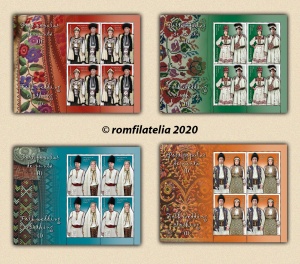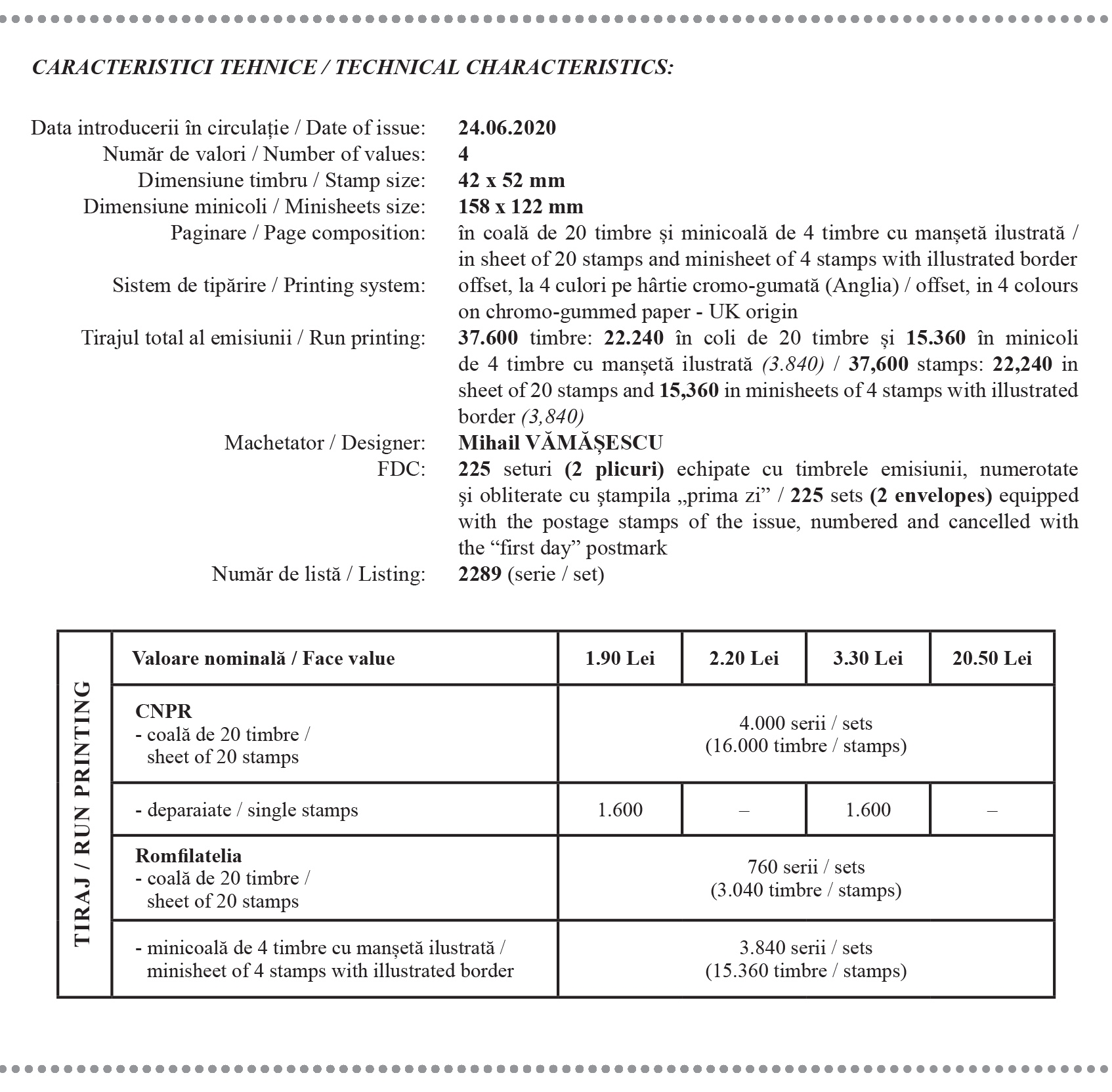Romfilatelia continues the series of philatelic topics dedicated to the folk costumes, through the postage stamps issue Folk wedding clothing (I), which will enter into circulation on Wednesday, June 24th, 2020. In the first part dedicated to this topic, folk wedding clothing are presented, in pairs, from the areas of Bucovina, Oas, Vlasca and Banat.
The traditional garment is primarily an element of material culture, and its variety is also influenced by other general factors, for all regions, such as: occupation, season, occasions, age, and sex. The care for the richest, most beautiful and unique ornamentation of the shirts, with various embroideries, was great. New motifs were sought everywhere, they were stolen, worked in secret.
The ornaments differentiate the shirts from one village to another, from one area to another, through their particularities of shape, colour, and technical execution. The variety of the design, the fantasy of the assembly, gives a special harmony to the whole composition. In this sense, the decorative composition of the shirts is, at the same time, wide, relaxed, full of allegory in the choice of symbols for the motifs, but at the same time sober and almost canonical, in their organization.
Wedding, bridal shirts were kept by women until death, they were buried with these shirts, considering them to have a ritual character.
The traditional folk costumes distinctive for Bucovina region are illustrated on the stamp with a face value of Lei 1.90. The bride’s gown consists of a shirt crinkled at the neck with “brezarau”, made of cotton homemade fabric, with the body made of three stani of fabric, with altite and sleeves. The decoration is very rich on altite and sleeves, where it is organized in sidelong rivers. The lower part of the body is covered with poale made of hemp cloth and a fota woven in four threads of wool and metal thread, with polychrome silk rods. The fota was fastened at the waist with a brau (belt) woven in 5 threads of polychrome wool, being decorated with geometric motifs. Over the shirt, the bride wore the pieptar with poale, made of 7 pieces of sheepskin, trimmed on the edges with lambskin, and on the front and the sleeves with “sofranit” (dyed) stone-marten fur. The chests of the pieptar are embroidered with polychrome phytomorphic motifs. The mark of the bride’s dress, the cununa (crown) and the companionship handkerchief are the strength pieces of the clothing, along with the silver thaler necklace.
The groom’s clothing consists of a straight linen shirt with monochrome embroidery on the poale and sleeves. The pants are simple, made of cotton and linen, tailored from a single width of fabric. The shirt is supported by a wide, polychrome wool belt, woven in 5 threads with geometric motifs. Over the shirt, they wore a long coat with poale, without sleeves, made of 7 pieces of sheepskin, garnished with sheep fur. The decoration of the men’s pieptar is much simpler than in the case of women’s pieptar. The mark of the groom’s clothing is the companionship handkerchief and the hat with “gang” and flower.
The stamp with the face value of Lei 2.20 shows the wedding costumes distinctive for Oas region. The bride’s gown, specific to holidays, presenting the shirt made of homemade fabric woven in two threads, with cotton warp and hemp weft, it typologically fits the shirts with “platca” (yoke). The embroidery is rich, and borders the yoke but also the cuffs, the ornaments having phytomorphic stylizations. The poale (skirts) and the sort (apron, tablier) are of the same type of fabric as the shirt. The skirts are decorated with material circles, and the apron features rich phytomorphic ornaments. Specific to the wedding clothing is the use of the abundant red colour on the shirt, skirt and apron. The specific adornment of the brides was the woollen crown and the zgarda, a collar of corals and silver coins.
The men’s clothing consists of a short shirt with a “platca” (yoke) made of homemade fabric woven in two threads, with cotton warp and hemp weft. The ornaments are distributed in ornamental fields at the collars and at the end of the sleeve. “Gacii” (trousers) are wide, made of 8 stani of hemp cloth, home woven, repeating the ornamental fields on the shirt. The distinctive item of the wedding clothing is the straw hat with ostrich feather and handkerchief embroidered by the bride. Another must-have accessory of the groom’s clothing was the embroidered bag, which was carried over the shoulder.
On the stamp with the face value of Lei 3.30 are represented the wedding folk costumes distinctive for Vlasca region. The bride’s gown consists of a shirt with altita and poale, made of cotton cloth in two threads, with a rich decoration arranged on the sleeves, chest and poale, the dominant being the carmine red colour. In addition to the natural silk embroidery, there are also sequins, fastened with glass beads. The bottom of the dress consists of a valnic (wollen kilt) crinkled in the back, called pesteman, and an apron in the front, made in the karamani technique, with polychrome wool. These two pieces are fastened at the waist with a narrow woollen brau (belt), which is tied up with a pair of paftale. The specific wedding headgear was the borangic marama and the fez with old Ottoman money.
The men’s wedding clothing consists of a straight, long shirt, made of cotton fabric woven in two threads, with rich embroidery on the neck, on the chest and sleeves, made with natural silk and sequins. The wide trousers, made of two stani of cloth, repeat at the end the embroidery on the bottom of the shirt. The waist is tied with a red wool belt woven in four threads. They wore a flowered lambskin hat on their heads.
The traditional wedding costumes distinctive for Banat region are illustrated on the stamp with the face value of Lei 20.50. The bride’s grown consists of a shirt crinkled at the neck, with the sleeve fastened in the bracelet with “fodori” (cuff made of crinkled fabric or embroidery, applied to sleeves). The sleeve has a sheet metal-like decoration, embroidered in Byzantine stitch with metallic thread. Both the poale (skirt) and the fodori (cuffs) of the shirt have embroidery and cotton “cipca”. The front catrinta (apron, tablier) and the “opreg” (narrower apron), a rectangular item with back fringes, are woven from wool with geometric motifs, chosen over threads, with metallic thread and polychrome wool. Catrinta and “opregul” are fastened at the waist with a velvet belt embroidered in Byzantine stitch, with metallic thread. The pieptar (sheepskin vest) is specific to the holidays, with wool embroidery and mirror pieces. The mark of the wedding clothing in the area is the “coin cap”, made of Austro-Hungarian thaler type coins.
The groom’s clothing consists of a straight shirt made of homemade fabric “in cinari” (in stripes made at the looming machine), with embroidery at cuffs and a collar made “at thread”, and at the poale “in ciur” – fagotting. The high collar of the shirt is the mark of the groom’s clothing. The wide trousers made of two sheets of cloth repeat the ornaments on the poala (hem, lower seamed part) of the shirt. The shirt is fastened in a leather belt, with embroidery in Byzantine stitch, made of metal thread. The laibar (corsage) is made of white aba, with ornaments made by applying coloured laces. The head was generally covered with black, lambskin, tugged cusma (winter hat).
Romfilatelia thanks the National Museum of the Romanian Peasant from Bucharest, for the documentary and photographic support granted to the achievement of this postage stamps issue.




